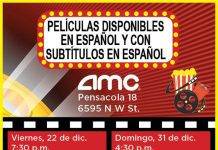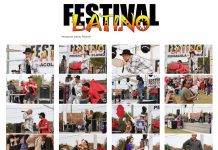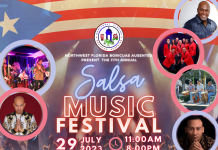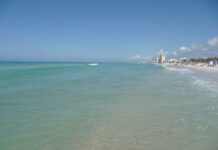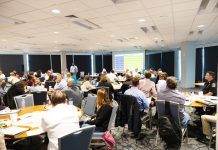El alcalde de Pensacola anuncia un grupo asesor para el estudio del cementerio del Parque Miraflores
PENSACOLA, Fla. – El alcalde D.C. Reeves seleccionó a 10 personas para que sirvan como el Grupo Asesor Comunitario del Estudio del Cementerio de Miraflores, que ayudará a la Ciudad de Pensacola en la evaluación y futura conmemoración del Parque Miraflores.
La Ciudad de Pensacola trabajará con el Grupo Asesor Comunitario, los socios y las partes interesadas de la comunidad a medida que avanza el estudio y continúa la investigación en el sitio.
El Grupo Asesor Comunitario del Estudio del Cementerio de Miraflores operará en Sunshine (Florida Statute 286.011), con todas las reuniones anunciadas públicamente, abiertas al público y con actas tomadas.
Aún no se ha programado la primera reunión del grupo asesor.
El estudio se lleva a cabo luego del descubrimiento de restos humanos en el Parque Miraflores en junio del 2021, la ciudad de Pensacola realizará un estudio de cementerio en los terrenos del parque con el objetivo de evaluar, interpretar y conmemorar el sitio.
Los restos humanos fueron descubiertos por una tropa local de Boy Scouts en el espacio debajo del edificio Boy Scout en el parque. Se contactó a las autoridades locales, incluido el Departamento de Policía de Pensacola, la Oficina del Médico Forense del Distrito 1, antropólogos biológicos de la Universidad de West Florida, así como la Oficina de Preservación Histórica del Estado de Florida y el Arqueólogo del Estado.
La investigación de campo indicó que los restos humanos estaban asociados con un relleno histórico y se originaron en un contexto de tumba histórica perturbada. Probablemente fueron perturbadas durante la construcción del edificio Boy Scout en el 1934.
Los antropólogos biológicos de la Universidad de West Florida realizaron un análisis esquelético que indicó que había dos individuos presentes, una mujer y probablemente un hombre. También se ha determinado que la jurisdicción para dirigir el estudio del cementerio es la ciudad de Pensacola.
La investigación determinó que los restos tienen más de 75 años, lo que significa que no son de un caso forense moderno. La ascendencia es difícil de determinar con restos óseos parciales, pero las características del individuo femenino sugieren que hay rasgos que se alinean con las diversas poblaciones conocidas en la Pensacola histórica, como la africana, la criolla y la europea.
El Parque Miraflores se conocía originalmente como Havana Square antes de ser renombrado en el 1965 como parte de la celebración de la Fiesta de Five Flags de Pensacola. La investigación histórica en curso ha identificado múltiples documentos históricos, incluidos artículos de periódicos, actas de reuniones, registros legales y un mapa que indica que Havana Square se usó como cementerio principalmente para personas de ascendencia afroamericana o criolla.
En el futuro, la investigación histórica continuará, junto con la tarea del Grupo Asesor de la Comunidad para explorar opciones para realizar una encuesta de radar de penetración terrestre. El sondeo de radar de penetración terrestre no invasivo ayudará a determinar si hay otros entierros potenciales presentes y delineará los límites del cementerio potencial para su conservación y protección en el futuro.
El Grupo Asesor Comunitario también tendrá la tarea de recopilar comentarios de la comunidad sobre cómo les gustaría ver el parque interpretado y conmemorado, y ayudar a generar ideas para el eventual reingreso de las dos personas. Este grupo llevará a cabo reuniones públicas, con oportunidades para el aporte y la participación del público durante todo el proceso.
Los miembros del Grupo Asesor Comunitario son:
- Barbara Albrecht, Coordinadora de Comunidades Costeras de la Universidad de West Florida, Directora de Panhandle Watershed Alliance
- Teniadé Broughton, Miembro del Concejo Municipal del Distrito 5, Presidente de la Sociedad John Sunday
- Rand Hicks, Presidente de la Junta de Parques y Recreación
- Angela Kyle, Vicepresidenta de Desarrollo de Negocios de Sostenibilidad en JLL, Líder del Área de Enfoque del Equipo de Transición de la Alcaldía para Planificación Estratégica
- Michelle MacNeil, Directora de Asuntos Arquitectónicos
- Allison Patton, Miembro del Concejo Municipal del Distrito 6
- Margo Stringfield, investigadora asociada del Instituto de Arqueología de la UWF
- Bianca Villegas, miembro de la Junta de Planificación
- Lonnie Wesley, pastor de la Iglesia Bautista Greater Little Rock, líder del área de enfoque del equipo de transición de la alcaldía para la participación ciudadana
- Lusharon Wiley, Vicepresidenta de Cultura Corporativa en Innisfree Hotels, Líder del Área de Enfoque del Equipo de Transición de la Alcaldía para la Cultura y el Compromiso de los Empleados
Pensacola mayor announces advisory group for Miraflores Park burial ground study
PENSACOLA, Fla. – Mayor D.C. Reeves has selected 10 individuals to serve as the Miraflores Burial Ground Study Community Advisory Group, which will assist the City of Pensacola in the assessment and future commemoration of Miraflores Park.
The City of Pensacola will be working with the Community Advisory Group, partners and community stakeholders as the study moves forward and research continues at the site.
The Miraflores Burial Ground Study Community Advisory Group will operate in the Sunshine (Florida Statute 286.011), with all meetings publicly advertised, open to the public, and minutes taken.
The first meeting of the advisory group has not yet been scheduled.
The study is being conducted following the discovery of human remains at Miraflores Park in June 2021, the City of Pensacola will be conducting a burial ground study of the park’s grounds with a goal of assessing, interpreting and commemorating the site.
The human remains were discovered by a local Boy Scout troop in the crawl space underneath the Boy Scout Building at the park. Local authorities were contacted including the Pensacola Police Department, the District 1 Medical Examiner’s Office, biological anthropologists from the University of West Florida as well as the Florida State Historic Preservation Office and the State Archaeologist.
The field investigation indicated that the human remains were associated with historic fill and originated from a historic, disturbed grave context. They were likely disturbed during the construction of the Boy Scout Building in 1934.
Biological anthropologists from the University of West Florida conducted a skeletal analysis that indicated there were two individuals present, one female and likely one male. It has also been determined that the jurisdiction of leading the study of the burial ground is the City of Pensacola.
The investigation determined that the remains are older than 75 years, meaning they are not from a modern, forensic case. Ancestry is difficult to determine with partial skeletal remains but features of the female individual suggest there are traits that align with the various known populations in historic Pensacola such as African, Creole, and European.
Miraflores Park was originally known as Havana Square before being renamed in 1965 as part of Pensacola’s Fiesta of Five Flags celebration. Ongoing historic research has identified multiple historic documents including newspaper articles, meeting minutes, legal records, and a map indicating that Havana Square was used as a burial ground primarily for people of African American or Creole descent.
Moving forward, historic research will continue, along with tasking the Community Advisory Group to explore options to conduct a ground penetrating radar survey. The noninvasive ground penetrating radar survey will help to determine if other potential burials are present and delineate the boundaries of the potential burial ground for future preservation and protection.
The Community Advisory Group will also be tasked with gathering feedback from the community on how they would like to see the park interpreted and commemorated, and to help generate ideas for eventual reinternment of the two individuals. This group will hold public meetings, with opportunities for public input and engagement throughout the process.
The members of the Community Advisory Group are:
- Barbara Albrecht, Coastal Communities Coordinator for the University of West Florida, Director of the Panhandle Watershed Alliance
- Teniadé Broughton, District 5 City Council Member, President of the John Sunday Society
- Rand Hicks, Parks and Recreation Board Chairman
- Angela Kyle, Vice President of Sustainability Business Development at JLL, Mayoral Transition Team Focus Area Leader for Strategic Planning
- Michelle MacNeil, Principal at Architectural Affairs
- Allison Patton, District 6 City Council Member
- Margo Stringfield, Research Associate for the UWF Archaeology Institute
- Bianca Villegas, Planning Board member
- Lonnie Wesley, Pastor of Greater Little Rock Baptist Church, Mayoral Transition Team Focus Area Leader for Citizen Engagement
- Lusharon Wiley, Vice President of Corporate Culture at Innisfree Hotels, Mayoral Transition Team Focus Area Leader for Employee Engagement & Culture




